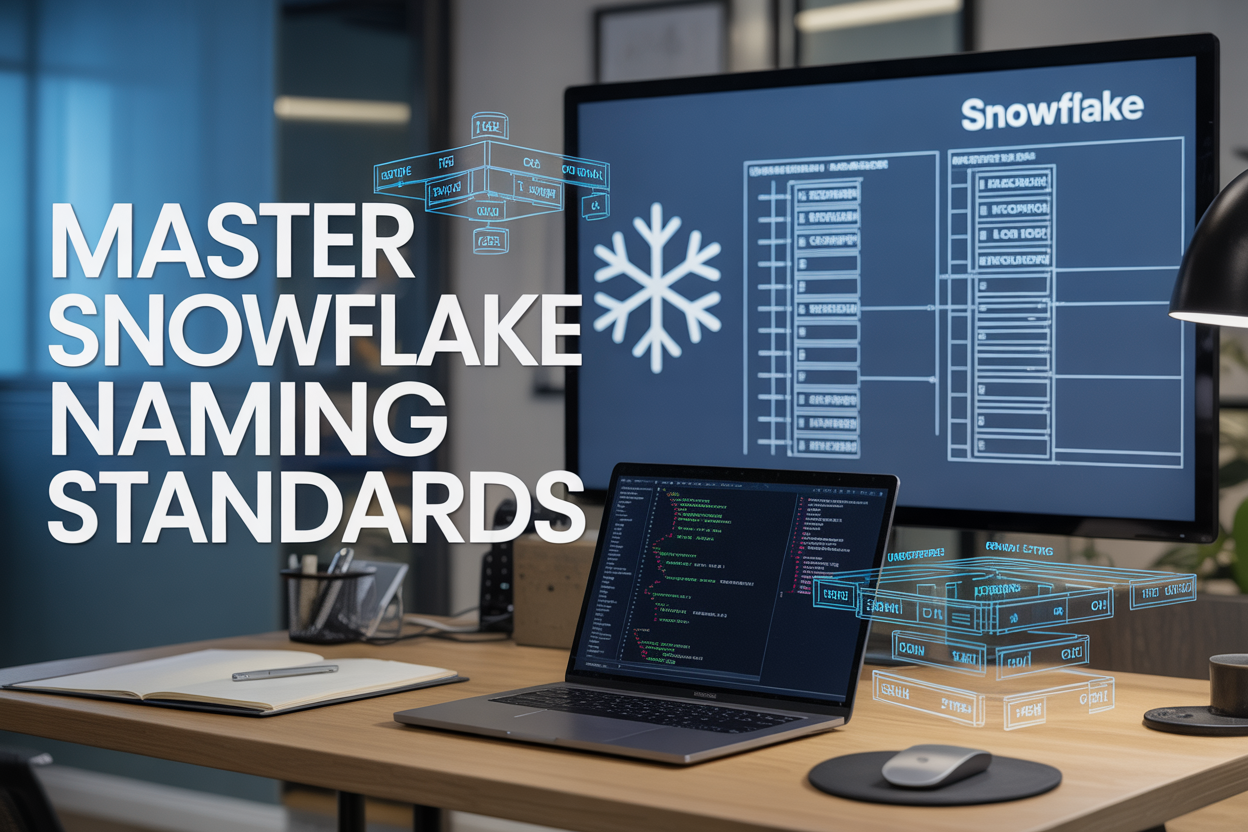Good Snowflake naming conventions can make or break your cloud data warehouse project. Poor naming standards lead to confused team members, security gaps, and maintenance nightmares that slow down your entire data platform.
This guide is for data engineers, architects, and administrators who want to build scalable, secure Snowflake environments from day one. You’ll learn how to create naming systems that grow with your organization and keep your data organized.
We’ll walk through foundation-level naming conventions for your core database objects and show you how to implement advanced naming standards for complex data warehousing components. You’ll also discover how strategic naming practices can strengthen your role-based security model and help your team scale faster.
By the end, you’ll have a complete framework for Snowflake object naming that supports both performance optimization and long-term growth across multiple environments.
Establish Foundation-Level Naming Conventions for Database Objects

Create consistent schema naming patterns that reflect business domains
Building a robust Snowflake naming convention starts with organizing your schemas around clear business domains. Think of schemas as the neighborhoods in your data city – each one should have a distinct purpose that’s immediately obvious to anyone walking through.
Your schema names should follow a predictable pattern that includes the business domain, data layer, and optionally the environment. For example: sales_raw, marketing_curated, finance_analytics. This approach creates a mental map for your team, making navigation intuitive even for newcomers.
Consider these proven schema naming patterns:
| Pattern Type | Example | Use Case |
|---|---|---|
| Domain-Layer | hr_raw, hr_staging, hr_mart |
Clear data pipeline progression |
| Function-Based | customer_360, product_catalog |
Business-specific data products |
| Source-Aligned | salesforce_raw, hubspot_staging |
External system integration |
Avoid generic names like temp, test, or misc. These become data graveyards where important information gets lost. Instead, be specific: sales_temp_q4_analysis tells a story that temp_schema_1 never could.
Define table naming standards that enable instant recognition of data types
Smart Snowflake database naming for tables eliminates the guesswork that slows down data teams. Your table names should instantly communicate what type of data lives inside, its freshness, and its intended use.
Start with a consistent prefix system that categorizes your tables by function. Raw tables might use raw_, fact tables could use fact_, and dimension tables dim_. This creates a visual hierarchy that speeds up queries and reduces errors.
Here’s a naming structure that works across different cloud data warehouse naming standards:
- Raw tables:
raw_[source]_[entity]→raw_salesforce_accounts - Staging tables:
stg_[domain]_[entity]→stg_sales_customers - Fact tables:
fact_[business_process]→fact_order_transactions - Dimension tables:
dim_[entity]→dim_customer
Include temporal indicators when tables capture point-in-time data: snapshot_inventory_daily or hist_customer_changes. This prevents confusion about data currency and helps analysts choose the right table for their analysis.
Avoid abbreviations that create confusion. While cust might save a few characters, customer leaves no room for interpretation. Your future self will thank you when debugging queries at 2 AM.
Implement column naming conventions that eliminate ambiguity
Column naming represents the finest level of your Snowflake naming conventions, where precision matters most. Ambiguous column names create endless Slack messages asking “What does this field actually contain?” – time better spent analyzing data.
Start every table with a primary key following the pattern [table_name]_id. For a customers table, use customer_id, not just id. This convention prevents join confusion and makes foreign key relationships crystal clear.
Establish clear patterns for common column types:
- Timestamps: Always suffix with the action –
created_at,updated_at,deleted_at - Flags: Use
is_orhas_prefixes –is_active,has_discount - Amounts: Include the unit –
price_usd,weight_kg,duration_minutes - Counts: Be specific –
total_orders,unique_visitors,failed_attempts
Group related columns with consistent prefixes. Address fields become address_street, address_city, address_state. This creates visual clustering in your table structure and makes SELECT statements more intuitive.
Avoid reserved words like date, order, user as column names. While Snowflake handles these with quotes, they create unnecessary complexity in queries and integrations.
Set up view and materialized view naming structures for optimal clarity
Views and materialized views serve as the polished interface to your raw data, so their names should reflect both their purpose and their relationship to underlying tables. Think of them as the friendly storefront while your tables are the warehouse behind.
Regular views should indicate they’re aggregated or transformed data with prefixes like vw_ or view_. Add descriptive suffixes that explain the transformation: vw_customer_monthly_summary or view_sales_pipeline_current.
Materialized views deserve special naming attention since they impact Snowflake performance optimization. Use mv_ prefixes and include refresh frequency hints: mv_daily_revenue_rollup or mv_hourly_user_activity. This helps your team understand the data freshness without checking metadata.
Consider these patterns for different view types:
| View Type | Pattern | Example |
|---|---|---|
| Reporting Views | rpt_[business_area]_[timeframe] |
rpt_sales_quarterly |
| Security Views | secure_[entity]_[purpose] |
secure_employee_directory |
| API Views | api_[version]_[endpoint] |
api_v2_customer_profile |
Name your views to match how business users think about the data. A view called customer_lifetime_value resonates better than clv_calculation_v3. Your naming should bridge the gap between technical implementation and business understanding.
Implement Advanced Naming Standards for Data Warehousing Components

Design staging area naming conventions that streamline ETL processes
Staging areas serve as temporary landing zones where raw data undergoes transformation before reaching production tables. A well-designed staging naming convention creates instant clarity about data lineage and processing status.
Start with a three-tier staging approach: STG_RAW_, STG_CLEAN_, and STG_FINAL_ prefixes. Raw staging tables should follow the pattern STG_RAW_{SOURCE_SYSTEM}_{ENTITY}_{YYYYMMDD} for daily loads or STG_RAW_{SOURCE_SYSTEM}_{ENTITY}_STREAM for continuous ingestion. For example, STG_RAW_SALESFORCE_ACCOUNTS_20240315 immediately tells you the source, entity, and load date.
Clean staging tables use STG_CLEAN_{DOMAIN}_{ENTITY} naming, such as STG_CLEAN_CUSTOMER_PROFILES or STG_CLEAN_SALES_TRANSACTIONS. This intermediate layer handles data quality, standardization, and basic transformations.
Final staging follows STG_FINAL_{TARGET_SCHEMA}_{ENTITY} patterns like STG_FINAL_ANALYTICS_CUSTOMER_SUMMARY. These tables contain business-ready data awaiting promotion to production schemas.
Include processing metadata in your staging conventions:
_DELTAsuffix for incremental changes_SNAPSHOTfor point-in-time captures_ARCHIVEfor historical preservation_ERRORfor failed record tracking
Schema organization becomes crucial with staging areas. Create dedicated schemas like STAGING_RAW, STAGING_CLEAN, and STAGING_FINAL to separate processing layers physically. This separation enables targeted access controls and simplifies monitoring.
Establish fact and dimension table naming patterns for star schema clarity
Star schema implementations in Snowflake require precise naming conventions that instantly communicate table relationships and business purpose. Snowflake naming conventions for dimensional modeling should reflect both technical structure and business context.
Dimension tables use the DIM_ prefix followed by the business entity: DIM_CUSTOMER, DIM_PRODUCT, DIM_TIME, DIM_GEOGRAPHY. Each dimension should have a singular noun that represents one business concept. Avoid abbreviations that create confusion – DIM_CUST is less clear than DIM_CUSTOMER.
For Type 2 slowly changing dimensions, add descriptive suffixes: DIM_CUSTOMER_SCD2 or use the pattern DIM_CUSTOMER_HISTORICAL. Bridge tables connecting many-to-many relationships follow BRIDGE_{DIM1}_{DIM2} like BRIDGE_CUSTOMER_PRODUCT.
Fact tables require FACT_ prefixes with clear business process names: FACT_SALES, FACT_INVENTORY_MOVEMENT, FACT_CUSTOMER_INTERACTIONS. Use specific, action-oriented names that describe what business event the fact table captures. Transaction-level facts might include _TXN suffix: FACT_SALES_TXN, while aggregated facts use _AGG: FACT_SALES_MONTHLY_AGG.
| Table Type | Pattern | Example |
|---|---|---|
| Dimension | DIM_{ENTITY} |
DIM_CUSTOMER |
| Fact | FACT_{PROCESS} |
FACT_SALES |
| Bridge | BRIDGE_{DIM1}_{DIM2} |
BRIDGE_PRODUCT_CATEGORY |
| Aggregate | FACT_{PROCESS}_{GRAIN}_AGG |
FACT_SALES_DAILY_AGG |
Key naming principles for star schemas include maintaining consistent grain indicators (_DAILY, _MONTHLY, _YEARLY) and using business terminology over technical jargon. Cloud data warehouse naming standards should align with business glossaries to ensure universal understanding across teams.
Create stored procedure and function naming standards that enhance maintainability
Snowflake stored procedures and functions require naming conventions that immediately communicate their purpose, input requirements, and expected outcomes. Well-named routines become self-documenting code that reduces maintenance overhead and accelerates development cycles.
Stored procedures should follow SP_{ACTION}_{OBJECT}_{QUALIFIER} patterns. Common actions include LOAD, TRANSFORM, VALIDATE, ARCHIVE, and REFRESH. Examples: SP_LOAD_CUSTOMER_DAILY, SP_TRANSFORM_SALES_AGGREGATE, SP_VALIDATE_DATA_QUALITY_CHECKS.
User-defined functions use UDF_{PURPOSE}_{DATATYPE} or UDF_{CALCULATION_TYPE} formats. Scalar functions might be UDF_CALCULATE_AGE_YEARS or UDF_MASK_SSN_STRING. Table functions follow UDTF_{RESULT_TYPE} like UDTF_SPLIT_ADDRESS_COMPONENTS.
Security-related procedures need special attention: SP_GRANT_{PERMISSION}_{OBJECT_TYPE}, SP_REVOKE_{PERMISSION}_{OBJECT_TYPE}, or SP_ROTATE_{CREDENTIAL_TYPE}. These patterns make security audits straightforward and reduce accidental permission changes.
Parameter naming within procedures should mirror your table column standards. Use descriptive names like INPUT_START_DATE, INPUT_BATCH_SIZE, and OUTPUT_STATUS_CODE rather than generic P1, P2 parameters.
Version control becomes essential with complex procedure libraries. Consider suffixes like _V1, _V2 for major version changes or date stamps _20240315 for deployment tracking. However, prefer schema-based versioning where procedures live in PROCEDURES_V1 and PROCEDURES_V2 schemas.
Documentation standards should be embedded in procedure names when possible. Procedures handling sensitive data might include _PII or _GDPR indicators, while those requiring special permissions could use _ADMIN or _ELEVATED suffixes.
Optimize Role-Based Security Through Strategic Naming Practices

Structure role names that clearly define access levels and responsibilities
Smart role naming in Snowflake security naming creates immediate clarity about what each role can do and where they fit in your organization’s hierarchy. Start with a consistent prefix system that identifies the access level – think ADMIN_, READ_ONLY_, or ANALYST_. This approach makes it crystal clear who has what permissions at a glance.
Build role names using a three-part structure: access level, department, and specific function. For example, ANALYST_MARKETING_CAMPAIGNS tells you exactly who this role serves and what they can access. Avoid generic names like USER1 or TEMP_ROLE that provide zero context about permissions or purpose.
Create role hierarchies that mirror your organizational structure. Parent roles like FINANCE_MANAGER should grant broader access than child roles like FINANCE_ANALYST_REPORTING. This naming pattern supports Snowflake’s role inheritance model and makes security audits straightforward.
| Role Type | Naming Pattern | Example |
|---|---|---|
| Administrative | ADMIN_{SCOPE}_{FUNCTION} | ADMIN_WAREHOUSE_OPERATIONS |
| Departmental | {DEPT}{LEVEL}{SPECIALTY} | SALES_MANAGER_FORECASTING |
| Functional | {FUNCTION}_{ACCESS_TYPE} | ETL_READ_WRITE |
| Service | SVC_{APPLICATION}_{PURPOSE} | SVC_TABLEAU_CONNECTOR |
Implement user naming conventions that support audit trails and compliance
User naming conventions become your first line of defense in compliance audits and security investigations. Establish a standard format that includes employee ID, department code, and user type. Something like E12345_MKTG_ANALYST immediately identifies the person, their department, and their role type.
Service accounts need special attention in your naming strategy. Prefix them clearly with SVC_ or APP_ to distinguish from human users. Include the application name and environment: SVC_TABLEAU_PROD or APP_AIRFLOW_DEV. This prevents confusion during security reviews and helps track automated processes.
Temporary users and contractors require their own naming pattern. Use prefixes like TEMP_ or CTR_ with expiration dates: TEMP_CONSULTANT_2024Q1. This makes it easy to identify accounts that need regular review and cleanup.
Document ownership clearly in user names when possible. Include team codes or project identifiers: CONTRACTOR_DATAENG_MIGRATION_2024. This creates natural audit trails and helps with access reviews when team members change roles or leave the organization.
Design warehouse and database naming standards that reflect security boundaries
Your warehouse and database names should act as security landmarks that clearly show data boundaries and access zones. Create naming patterns that immediately communicate sensitivity levels and data classifications. Use prefixes like PROD_, DEV_, SANDBOX_ to establish environmental boundaries that align with your security policies.
Database naming should reflect both business domains and security classifications. Pattern your names like {ENV}_{DOMAIN}_{CLASSIFICATION} – for example, PROD_FINANCE_RESTRICTED or DEV_MARKETING_INTERNAL. This approach makes data governance policies self-evident through the naming structure.
Warehouse names need to balance performance requirements with security boundaries. Use patterns that indicate both the workload type and security zone: PROD_ANALYTICS_SECURE, DEV_ETL_SANDBOX, or RESEARCH_ADHOC_RESTRICTED. This helps administrators quickly understand resource allocation and access requirements.
Consider data residency and compliance requirements in your naming. Include region codes or compliance frameworks: US_PROD_CUSTOMER_PCI or EU_ANALYTICS_GDPR. This becomes critical for organizations operating across multiple jurisdictions with different data protection requirements.
Create integration naming patterns that support cross-team collaboration
Integration objects need naming conventions that bridge different teams and systems while maintaining security clarity. Design patterns that include source system, destination, and data flow direction. Something like INT_SALESFORCE_TO_SNOWFLAKE_CONTACTS immediately shows the integration path and purpose.
API users and integration roles should follow consistent patterns that identify both the system and the integration type. Use formats like API_{SYSTEM}_{DIRECTION}_{PURPOSE}: API_TABLEAU_READ_DASHBOARDS or API_AIRFLOW_WRITE_STAGING. This makes it easy to track which systems connect to your Snowflake instance and what they’re allowed to do.
Schema naming for integration data should reflect both the source system and the integration pattern. Create standards like {SOURCE}_RAW, {SOURCE}_STAGING, {SOURCE}_TRANSFORMED. For example: SALESFORCE_RAW, HUBSPOT_STAGING, ZENDESK_TRANSFORMED. This creates clear data lineage through naming alone.
External stage and file format names need similar clarity for cross-team work. Use patterns that show the data source and processing stage: STAGE_S3_CUSTOMER_DATA_RAW or FORMAT_CSV_TRANSACTION_LOGS. Teams working with these objects can immediately understand their purpose and data expectations without digging through documentation.
Scale Your Data Architecture with Environment-Specific Naming Rules

Establish development, staging, and production naming distinctions
Environment-specific naming conventions form the backbone of scalable cloud data platforms. Smart organizations build their Snowflake naming standards around clear environment distinctions that prevent costly mistakes and streamline deployment processes.
The most effective approach uses environment prefixes that immediately identify the data’s purpose. Development environments typically use DEV_ prefixes, while staging uses STG_ and production adopts PROD_. This simple system prevents accidental cross-environment queries and makes debugging infinitely easier.
| Environment | Database Prefix | Schema Example | Table Example |
|---|---|---|---|
| Development | DEV_ |
DEV_ANALYTICS.SALES |
DEV_ANALYTICS.SALES.CUSTOMER_ORDERS |
| Staging | STG_ |
STG_ANALYTICS.SALES |
STG_ANALYTICS.SALES.CUSTOMER_ORDERS |
| Production | PROD_ |
ANALYTICS.SALES |
ANALYTICS.SALES.CUSTOMER_ORDERS |
Production databases often drop the prefix entirely, creating cleaner naming while maintaining clarity. This approach works particularly well when combined with Snowflake’s account-level separation between environments.
Consider implementing color-coded naming schemes for visual clarity. Development might use GREEN_, staging YELLOW_, and production RED_ to create instant visual recognition. Teams working with multiple projects benefit from project-specific environment naming like PROJECT_A_DEV_ or ECOM_STG_.
Implement version control naming conventions for schema evolution
Database schema evolution demands systematic naming conventions that track changes over time. Snowflake’s cloud data warehouse architecture makes schema versioning straightforward when you establish clear naming patterns from the start.
Version numbering follows semantic versioning principles adapted for data structures. Use V1_0, V2_0 for major schema changes, V1_1, V1_2 for minor updates, and V1_1_1 for patches. Major versions indicate breaking changes, minor versions add new columns or tables, and patches fix data types or constraints.
Time-based versioning offers another powerful approach. Schemas named CUSTOMER_DATA_2024_Q1 or SALES_SCHEMA_20240315 provide instant chronological context. This method works exceptionally well for data warehouses handling seasonal business cycles or regulatory reporting periods.
Branch-based naming aligns with software development workflows. Feature branches become FEATURE_NEW_ANALYTICS_SCHEMA, while release candidates use RC_ANALYTICS_V2_1. This naming convention integrates seamlessly with CI/CD pipelines and helps development teams maintain consistency across code and data structures.
Archive schemas require special attention. Use ARCHIVED_ prefixes combined with timestamps: ARCHIVED_CUSTOMER_DATA_20231201. This approach keeps historical schemas accessible while clearly marking them as deprecated.
Document schema evolution through naming conventions that include change indicators. Tables modified in specific versions can include version suffixes: CUSTOMER_ORDERS_V2_1_MODIFIED. This granular tracking helps teams understand exactly what changed between versions.
Design backup and recovery naming standards that ensure rapid restoration
Recovery operations succeed or fail based on naming clarity. When systems crash at 3 AM, your backup naming conventions become the difference between quick recovery and extended downtime. Snowflake’s Time Travel and Fail-safe features work best with systematic naming approaches.
Backup naming must capture three critical elements: source object, timestamp, and backup type. The pattern BACKUP_[OBJECT]_[YYYYMMDD_HHMMSS]_[TYPE] provides complete context. For example: BACKUP_CUSTOMER_ORDERS_20240315_143022_FULL or BACKUP_ANALYTICS_DB_20240315_143022_INCREMENTAL.
Recovery point objectives drive naming granularity. Daily backups might use DAILY_BACKUP_ANALYTICS_20240315, while hourly backups need HOURLY_BACKUP_ANALYTICS_20240315_14. Critical systems often require minute-level precision: BACKUP_TRANSACTIONS_20240315_143045.
Retention policies integrate directly into naming conventions. Use retention indicators like 7DAY_BACKUP_, 30DAY_BACKUP_, or YEARLY_BACKUP_ to automate cleanup processes. This approach prevents storage bloat while ensuring compliance with data retention requirements.
Geographic backup distribution requires location identifiers. Multi-region deployments benefit from naming like BACKUP_US_EAST_CUSTOMER_DATA_20240315 or BACKUP_EU_WEST_ANALYTICS_20240315. These conventions support disaster recovery strategies and regulatory compliance across different jurisdictions.
Test restore naming creates clear separation between production recovery and testing activities. Use TEST_RESTORE_ prefixes for validation exercises: TEST_RESTORE_CUSTOMER_ORDERS_20240315_143022. This prevents confusion during actual emergencies and maintains production system integrity.
Maximize Performance Through Intelligent Object Organization

Create clustering key naming conventions that optimize query performance
Clustering keys serve as Snowflake’s secret weapon for turbocharging query performance, and smart naming conventions can make the difference between lightning-fast queries and sluggish data retrieval. Your clustering key names should instantly communicate their purpose and column relationships to anyone managing the data platform.
Start with descriptive prefixes that indicate the clustering strategy. Use CL_DATE_ for date-based clustering, CL_REGION_ for geographic clustering, or CL_CUSTOMER_ for customer-centric partitioning. This approach helps database administrators quickly identify clustering patterns across tables without diving into table definitions.
| Clustering Type | Naming Pattern | Example |
|---|---|---|
| Date-based | CL_DATE_{table}_{column} |
CL_DATE_SALES_ORDER_DATE |
| Geographic | CL_REGION_{table}_{column} |
CL_REGION_CUSTOMER_STATE |
| Multi-column | CL_MULTI_{table}_{priority} |
CL_MULTI_ORDERS_PRIORITY1 |
Multi-column clustering keys deserve special attention in your Snowflake naming conventions. Append priority indicators like _P1, _P2 to show column order importance. For example, CL_MULTI_TRANSACTIONS_DATE_P1_REGION_P2 clearly shows that date clustering takes precedence over region clustering.
Document clustering key changes with version numbers. When rebuilding clustering strategies, use patterns like CL_V2_DATE_SALES_ORDER_DATE to track evolution and performance improvements over time.
Implement index naming standards that accelerate troubleshooting processes
While Snowflake doesn’t use traditional indexes like other databases, search optimization services and automatic clustering require systematic naming approaches for effective Snowflake performance optimization. These naming standards become critical when troubleshooting performance bottlenecks across your cloud data warehouse.
Search optimization configurations need clear, consistent names that reflect their target columns and intended use cases. Use the pattern SO_{table_name}_{column_group}_{purpose} for search optimization services. For instance, SO_CUSTOMER_LOOKUP_SEARCH indicates search optimization on customer lookup columns, while SO_PRODUCT_FILTER_ANALYTICS shows optimization for analytical filtering operations.
When working with automatic clustering, name your clustering keys to reflect maintenance windows and performance characteristics. Use AUTO_CL_{frequency}_{table}_{strategy} patterns like AUTO_CL_DAILY_SALES_DATE or AUTO_CL_WEEKLY_INVENTORY_LOCATION to communicate clustering refresh schedules.
Create naming conventions for query acceleration services that clearly identify their scope and purpose:
QA_DASHBOARD_{dashboard_name}for dashboard-specific accelerationQA_REPORT_{report_type}_{frequency}for scheduled reporting optimizationQA_ADHOC_{department}_{use_case}for department-specific ad hoc query optimization
These patterns help your team quickly identify which optimization services impact specific queries during troubleshooting sessions, reducing mean time to resolution for performance issues.
Design partition naming patterns that enhance data lifecycle management
Smart partition naming in Snowflake transforms data lifecycle management from a complex juggling act into a streamlined, automated process. Your partition naming conventions should encode retention policies, archival schedules, and access patterns directly into object names.
Time-based partitions form the backbone of most data lifecycle strategies. Use the format {table_name}_PART_{YYYY_MM}_{retention_policy} to embed both temporal information and lifecycle rules. Examples include SALES_TRANSACTIONS_PART_2024_01_HOT for current data requiring fast access, or AUDIT_LOGS_PART_2023_12_COLD for archived data with extended retention.
Implement lifecycle indicators that automate data management decisions:
HOT - Active data, frequent access (0-90 days)
WARM - Semi-active data, moderate access (91-365 days)
COLD - Archive data, infrequent access (1-7 years)
FROZEN - Compliance data, minimal access (7+ years)
Geographic partitions need similar attention for global cloud data architecture best practices. Use patterns like {table_name}_GEO_{region}_{data_class} such as CUSTOMER_DATA_GEO_EU_PII or SALES_METRICS_GEO_APAC_ANALYTICS to support data residency requirements and regional performance optimization.
Create partition naming standards that support automated lifecycle policies. Include deletion dates directly in names using {table_name}_PART_{date}_DEL_{YYYY_MM_DD} format, enabling automated cleanup scripts to identify and process partitions based on naming patterns alone.
Establish stream and task naming conventions for real-time processing efficiency
Real-time processing in Snowflake depends heavily on streams and tasks working together seamlessly, making consistent naming conventions essential for operational efficiency. Your stream and task names should clearly indicate data flow direction, processing frequency, and dependencies.
Stream naming should follow the pattern STR_{source_table}_{target_table}_{change_type} to immediately communicate data lineage. Use STR_ORDERS_WAREHOUSE_INSERTS for capturing new order insertions or STR_INVENTORY_ANALYTICS_ALL_CHANGES for comprehensive change data capture. This approach makes data flow troubleshooting much more straightforward.
Task naming conventions need to reflect both scheduling and dependencies. Use TSK_{frequency}_{process_name}_{sequence} patterns like TSK_5MIN_ORDER_PROCESSING_01 or TSK_HOURLY_INVENTORY_SYNC_03. The sequence number helps identify task chains and execution order when multiple tasks process the same data stream.
| Stream Type | Naming Pattern | Example |
|---|---|---|
| Insert-only | STR_{source}_{target}_INS |
STR_ORDERS_DW_INS |
| All changes | STR_{source}_{target}_ALL |
STR_CUSTOMER_CDW_ALL |
| Update-focused | STR_{source}_{target}_UPD |
STR_PRODUCT_CACHE_UPD |
Establish error handling naming conventions for failed streams and tasks. Use ERR_{original_name}_{error_type} patterns to quickly identify problematic components. Examples include ERR_STR_ORDERS_DW_TIMEOUT or ERR_TSK_INVENTORY_DEPENDENCY_FAIL.
Create monitoring-friendly names that integrate with Snowflake’s task history and stream status functions. Prefix mission-critical processes with CRITICAL_ and development processes with DEV_ to enable filtered monitoring and alerting based on naming patterns alone.

Following solid naming conventions in Snowflake isn’t just about keeping things tidy—it’s about building a data platform that can grow with your business. When you establish clear standards for databases, warehouses, roles, and environments from the start, you’re setting up your team for long-term success. Good naming practices make your data architecture self-documenting, reduce confusion, and help new team members get up to speed quickly.
Smart naming goes hand-in-hand with better performance and security. When your objects are organized logically and your roles follow predictable patterns, troubleshooting becomes easier and access management stays under control. Take the time to define your standards early, document them well, and make sure everyone on your team follows them consistently. Your future self—and anyone else working with your Snowflake environment—will thank you for the effort.




















